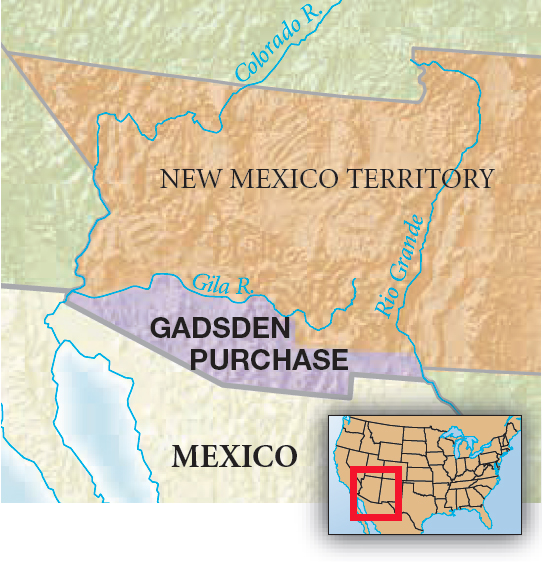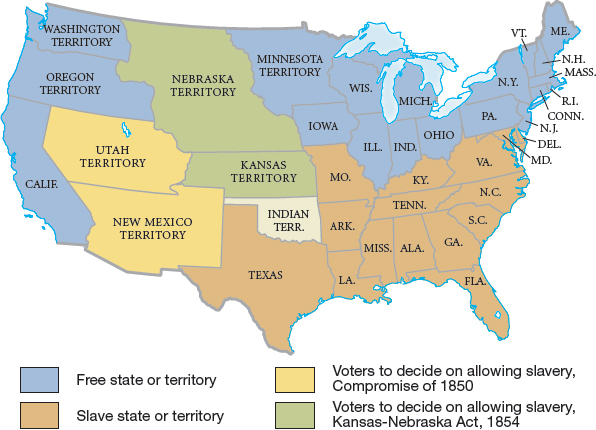The Kansas-Nebraska Act
Printed Page 400
As the 1852 election approached, the Democrats and Whigs sought to close the sectional rifts that had opened within their parties. For their presidential nominee, the Democrats turned to Franklin Pierce of New Hampshire. Pierce’s well-known sympathy with southern views on public issues caused his northern critics to include him among the “doughfaces,” northern men malleable enough to champion southern causes. The Whigs chose another Mexican-American War hero, General Winfield Scott of Virginia. But the Whigs’ northern and southern factions were hopelessly divided, and the Democrat Pierce carried twenty-seven states to Scott’s four and won the electoral college vote 254 to 42 (see Map 14.4). The Free-Soil Party lost almost half of the voters who had turned to it in the tumultuous political atmosphere of 1848.
Eager to leave the sectional controversy behind, the new president turned swiftly to foreign expansion. Manifest destiny remained robust. Pierce’s major objective was Cuba, but when antislavery Northerners blocked Cuba’s acquisition to keep more slave territory from entering the Union, he turned to Mexico. In 1853, diplomat James Gadsden negotiated a $10 million purchase of some 30,000 square miles of land in present-day Arizona and New Mexico. The Gadsden Purchase furthered the dream of a transcontinental railroad to California and Pierce’s desire for a southern route through Mexican territory. Talk of a railroad ignited rivalries in cities from New Orleans to Chicago as they maneuvered to become the eastern terminus. Inevitably in the 1850s, the contest for a transcontinental railroad became a sectional struggle over slavery.

CHAPTER LOCATOR
Why did the acquisition of land from Mexico contribute to sectional tensions?
What factors helped unravel the balance between slave and free states?
How did the party system change in the 1850s?
Why did northern fear of the “Slave Power” intensify in the 1850s?
Why did some southern states secede immediately after Lincoln’s election?
Conclusion: Why did political compromise fail?
 LearningCurve
LearningCurve
Check what you know.
Illinois’s Democratic senator Stephen A. Douglas badly wanted the transcontinental railroad for Chicago. Any railroad that ran west from Chicago would pass through a region that Congress in 1830 had designated a “permanent” Indian reserve (see "Indian Policy and the Trail of Tears" in chapter 11). Douglas proposed giving this vast area between the Missouri River and the Rocky Mountains an Indian name, Nebraska, and then throwing the Indians out. Once the region achieved territorial status, whites could survey and sell the land, establish a civil government, and build a railroad.
Nebraska lay within the Louisiana Purchase and, according to the Missouri Compromise of 1820, was closed to slavery (see "The Missouri Compromise" in chapter 10). Douglas needed southern votes to pass his Nebraska legislation, but Southerners had no incentive to create another free territory or to help a northern city win the transcontinental railroad. Southerners, however, agreed to help if Congress organized Nebraska according to popular sovereignty. That meant giving slavery a chance in Nebraska Territory and reopening the dangerous issue of slavery expansion.
In January 1854, Douglas introduced his bill to organize Nebraska Territory, leaving to the settlers themselves the decision about slavery. At southern insistence, Douglas added an explicit repeal of the Missouri Compromise. Free-Soilers branded Douglas’s plan “a gross violation of a sacred pledge” and an “atrocious plot” to transform free land into a “dreary region of despotism, inhabited by masters and slaves.”
Undaunted, Douglas skillfully shepherded the explosive bill through Congress in May 1854. Nine-tenths of the southern members (Whigs and Democrats) and half of the northern Democrats cast votes in favor of the bill. Like Douglas, most northern supporters believed that popular sovereignty would make Nebraska free territory. The Kansas-Nebraska Act divided the huge territory in two: Nebraska and Kansas (Map 14.3). With this act, the government pushed the Plains Indians farther west, making way for farmers and railroads.
 1854 law that divided Indian territory into Kansas and Nebraska, repealed the Missouri Compromise, and left the new territories to decide the issue of slavery on the basis of popular sovereignty. The measure led to bloody fighting in Kansas.
1854 law that divided Indian territory into Kansas and Nebraska, repealed the Missouri Compromise, and left the new territories to decide the issue of slavery on the basis of popular sovereignty. The measure led to bloody fighting in Kansas.

QUICK REVIEW
Question
Why did the Compromise of 1850 fail to achieve sectional peace?
CHAPTER LOCATOR
Why did the acquisition of land from Mexico contribute to sectional tensions?
What factors helped unravel the balance between slave and free states?
How did the party system change in the 1850s?
Why did northern fear of the “Slave Power” intensify in the 1850s?
Why did some southern states secede immediately after Lincoln’s election?
Conclusion: Why did political compromise fail?
 LearningCurve
LearningCurve
Check what you know.